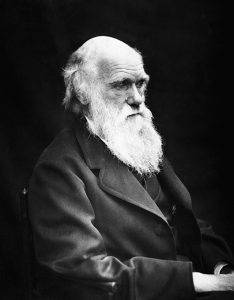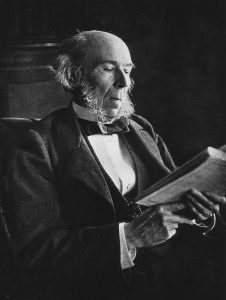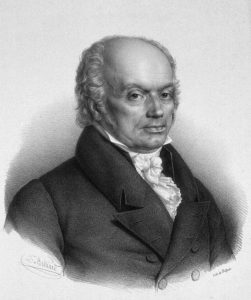6 Biological Influences
Evolution and Darwinism
Theories on evolution have existed since the times of Ancient Greece. Greek philosopher Anaximander, for example, described how creatures originated in water and developed to fit their current environments (Warmflash, 2018). However, the earlier hypotheses about evolution do not compare to the evidence-based, comprehensive description of evolution by natural selection that Charles Darwin introduced to the world.
Charles Darwin (1809-1882)

Born in Shrewsbury, England, into a wealthy, educated family, Darwin grew up in an environment that nurtured his intellect and curiosity (Bowler, 2002). During his school days, Darwin was heavily interested in the sciences, especially chemistry. Later, as a medical student in Edinburgh, he spent time observing and dissecting marine creatures. During his university years, Darwin became exposed to many naturalists, individuals who observed and contemplated nature and its intricacies. However, Darwin had little passion for becoming a physician, and his father decided a clergyman would be a better career choice. While studying at Cambridge to become one, Darwin met John Stevens Henslow, who convinced Darwin to become a naturalist. When Darwin found out that the captain of the ship HMS Beagle was looking for a naturalist to join his expedition to South America, he was eager to join. In December of 1831, the ship deployed on its five-year journey.
When Darwin got to the Galapagos islands in 1835, where he came across the South American bird, the finch. He noted that different islands had different species of finches, each with different-shaped beaks. Darwin then understood that beak shape and size corresponded to the type of food the finches ate. Therefore, it is likely that the ancestral finches came from the South American mainland to the islands, and adapted to the environment of the island they resided on, more specifically, the food type. For example, if the ancestral finches arrived on an island with hard-to-open seeds as a food source, finches with sharper beaks would have access to the food source, survive and mate, creating further generations of sharp-beaked finches. Finches with other types of beaks, which could not open the seeds, would be less likely to survive and pass on their genes to the next generation, and therefore would be selected out of the population. Therefore, due to the varying food sources on each island, a new species of finch would develop on different islands. Due to his observations on the Galapagos, Darwin began questioning his previous beliefs on creation, and the genesis of the theory of evolution by natural selection began.
When Darwin returned to England in 1838, he was faced with a dilemma. Growing up a creationist, Darwins was taught that God created nature as it was, including all animal species. This was the prevailing view a the time, and countering it would be faced with harsh criticism. For twenty years after returning from his trip, Darwin spent his days forming his theory of evolution by natural selection. Darwin believed that species could not just be created randomly, and found that fossil records prove that new species arise from old ones. Darwin also noticed how farmers selected the traits they wanted in their livestock by selectively breeding the animals. For example, if a farmer wanted a population of larger, meatier cows, they would only breed the largest male and females of each generation, and keep only the offspring that fit that description as well. Over generations, this would create a population of large, meaty cows. Humans selecting for desirable plant and animal species is termed artificial selection, and it caused Darwin to question whether something similar can occur in nature. Finally, Darwin came to the conclusion that evolution by natural selection occurs when the traits that best suit the environment and increase the chances of survival and reproduction in an animal will be passed on to the next generation, and lead to the evolution of a new species.
in 1858, along with Alfred Russel Wallace, who came to a similar conclusion, Darwin presented his theory to the world (Kauth, 2007). In 1859, Darwin published On the Origin of Species By Means of Natural Selection, which influenced the shift of biology from the creationist view to one based on evolutionary theory. Darwin’s views also influenced the field of psychology, as Darwin did not make a great distinction between animals and humans. In The Descent of Man, Darwin stated that human mental functions can be attributed to natural selection (Bolhuis, Brown, Richardson & Laland, 2011).
References
Bolhuis, J. J., Brown, G. R., Richardson, R. C., & Laland, K. N. (2011). Darwin in Mind: New Opportunities for Evolutionary Psychology. PLoS Biology, 9(7), e1001109. https://doi.org/10.1371/journal.pbio.1001109
Bowler, P. J. (2002). Charles Darwin : the man and his influence. Cambridge University Press.
Kauth, M. R. (2007). A Brief History of the Theory of Evolution. Journal of Psychology & Human Sexuality, 18(2-3), 23–68. https://doi.org/10.1300/j056v18n02_02
Spencer, H., & Duncan, D. (2014). The life and letters of Herbert Spencer. Cambridge Univ. Press.
Warmflash, D. (2018, February 18). Visionlearning • Your insight into science. Www.visionlearning.com. https://www.visionlearning.com/blog/2018/02/21/anaximander-evolution-earth-body-space-experiment/
Further Reading
Darwin, C. (1871). The descent of man. New York: D. Appleton.
Darwin, C. (1909). The origin of species (pp. 95-96). New York: PF Collier & son.
Herbert Spencer (1820-1903)

Herbert Spencer was a British philosopher and sociologist in the Victorian era. His views on evolution, sociology and psychology have made him one of the most influential thinkers of his time.
Spencer was born in Derby, England, and grew up receiving a largely informal education (Sweet, n.d.). Eventually, Spencer pursued a career as a journalist, focusing on political writing. However, throughout his life, Spencer wrote a variety of texts and created “synthetic philosophy”, which consists of “applying evolutionary theory to philosophy, psychology and the study of society” (Sweet, n.d.). He wrote on evolution before Darwin published the Origin of Species, and argued that nature’s purpose is to promote the creation of the most powerful and adaptive society, with the process consisting of eliminating the weakest. In his book, Principles of Biology (1864), Spencer coined the term “survival of the fittest” (Falk, 2020). In his theory of “social Darwinism”, Spencer argued that natural selection can be applied to human beings, specifically when it comes to social standing (Rogers, 1972). Spencer believed that certain individuals in society are more successful and powerful because they are innately “more fit”, and people who are not fit for society should be free to do as they want, because they will die out anyway. Therefore, the government should not help underprivileged individuals, as this would disrupt the natural order of things and propagate the survival of those not fit for society. This controversial theory has been used as a platform for many ableist, sexist and racist agendas, and has even been condemned by Darwin (History.com Editors, 2018).
References
History.com Editors. (2018, August 21). Social Darwinism. HISTORY; A&E Television Networks. https://www.history.com/topics/early-20th-century-us/social-darwinism#:~:text=Social%20Darwinists%20believe%20in%20%E2%80%9Csurvival
Rogers, J. A. (1972). Darwinism and Social Darwinism. Journal of the History of Ideas, 33(2), 265. https://doi.org/10.2307/2708873
Sweet, W. (n.d.). Spencer, Herbert | Internet Encyclopedia of Philosophy. Retrieved from https://iep.utm.edu/spencer/#H1
Perception
Under construction.
Hypnosis
Hypnosis is the “induction of a deeply relaxed state” (Vickers & Zollman, 1999, p. 1346). Early psychologists and psychoanalysts believed that hypnosis can be used to access the human unconscious, and treat psychological disorders. Although hypnosis is often considered taboo and pseudoscience, it is still used today in modern treatments.
Franz Anton Mesmer (1734-1815)
Mesmer was born in Iznang (modern-day Moos), Germany, and studied in Jesuit schools for most of his life (Thomas, 2012). In 1759, he began his medical studies in Vienna, and upon graduation, published a thesis on how gravitational tides affect the human body, and how they can be used for healing*. Mesmer believed that all living things had a “magnetic fluid”, which he called animal magnetism (mesmerism). He stated that illness could be cured using magnets to restore an individual’s animal magnetism. To treat his patients, Mesmer would put them into a deeply relaxed, trance-like state and place magnets on the afflicted parts of the body (APA Dictionary of Psychology, 2022). Mesmer would move his hands above the patient’s body, believing it would cause the magnetic fluid to treat the afflicted parts of the body (Forrest, 2002). Using these methods, Mesmer claimed to cure menstrual pains, paralysis, and chronic vomiting. In 1784, while Mesmer worked in Paris, the French king established a committee to determine the validity of animal magnetism. The committee determined that there was no proof of the existence of animal magnetism, and no actual beneficial effects of Mesmer’s treatment, other than possible placebo effects. After this humiliation, Mesmer left Paris and practiced as a physician all over Europe until his death (Rich & Gielen, 2015). Although Mesmer’s technique had been publically renounced, his influence began the movement of hypnosis (mesmerism) in Europe.
Before Mesmer, psychology was mostly a theoretical philosophy, with few applications of theory to treatment (Mongiovi, 2022). Mesmer was one of the first to introduce how an altered conscious state can be used to treat illness.
References
APA Dictionary of Psychology. (2022). Dictionary.apa.org. https://dictionary.apa.org/mesmerism
Forrest, D. (2002). Mesmer. International Journal of Clinical and Experimental Hypnosis, 50(4), 295–308. https://doi.org/https://doi.org/10.1080/00207140208410106
Mongiovi, J. (2022). Hypnosis & Psychology. Johnmongiovi.com. https://johnmongiovi.com/pages/psychology#:~:text=Freud%20referred%20to%20hypnosis%20as
Rich, G.J. & Gielen, U. P. (2015b). Pathfinders in international psychology. Information Age Publishing Inc.
Thomas, R. K. (2012). Mesmer, Franz Anton. In Encyclopedia of the history of psychological theories (Vol. 2, pp. 672-673. New York, NY: Springer-Verlag
Vickers, A., & Zollman, C. (1999). ABC of complementary medicine: Hypnosis and relaxation therapies. BMJ, 319(7221), 1346–1349. https://doi.org/10.1136/bmj.319.7221.1346
Further Reading
*“Physico-Medical Dissertation on the Influence of the Planets” (Mesmer, 1766/1971)
Hypnosis in Psychoanalysis
Hypnosis as a treatment for mental and physical disorders has been used in a variety of cultures, and dates back hundreds of years. However, hypnosis in relation to psychoanalysis can only be traced to the past hundred years.
After Mesmer’s introduction of hypnosis, or mesmerism, to Europe, several physicians and psychologists took an interest in hypnosis as a treatment (Klocek, 2021). Many reported successful results when using the treatment on their patients. 19th-century neurologist Jean-Martin Charcot introduced hypnosis to the clinical psychiatric field, and many physicians took interest in the treatment. According to Sigmund Freud, the father of psychoanalysis, the human unconscious is filled with desire and prohibitions of desire (Peebles-Kleiger, 2001). When desire and its prohibition are constantly in conflict, mental illnesses, such as phobias and anxieties arise. In order to treat such conflict, the individual’s defences need to be brought down, and the happenings of the unconscious could be revealed. Once these desires are brought to the conscious, they could be evaluated and the conflicting, distressing feelings can be relieved. Freud used hypnosis to bring forth the patient’s hidden thoughts and feelings for about ten years, before switching to free association (Mongiovi, 2022). Due to Freud’s influence and the death of Charcot, the use of hypnosis as a treatment declined in Europe until the 20th century (Klocek, 2021).
The early 20th century revealed that when hypnosis is combined with other medical treatments, it has great therapeutic effects, and the practice was beginning to be reintegrated into medical practice. Hypnosis was even used on traumatized soldiers of the World Wars. In the 1950s, the creation of the Laboratory of Hypnosis Research at Stanford University triggered research on how to make hypnosis an empirical method. Many years of research and practice led to hypnosis finally being recognized by medical societies as a viable method of treatment (Stewart, 2005; as cited in Klocek, 2021). Modern treatments use hypnosis to help treat disorders such as anxiety, panic disorders and insomnia (Vickers & Zollman, 2001).
References
Elkins, G. R. (2014). Hypnotic relaxation therapy : principles and applications. Springer Pub. Co.
Klocek, J. (2021). History of Medical and Psychological Hypnosis. In connect.springerpub.com. Springer Publishing Company. https://connect.springerpub.com/content/book/978-0-8261-2487-6/part/part01/chapter/ch01#:~:text=Hypnosis%20has%20its%20origin%20in
Mongiovi, J. (2022). Hypnosis & Psychology. Johnmongiovi.com. https://johnmongiovi.com/pages/psychology#:~:text=Freud%20referred%20to%20hypnosis%20as
Peebles-Kleiger, M. J. (2001). Contemporary psychoanalysis and hypnosis. International Journal of Clinical and Experimental Hypnosis, 49(2), 146–165. https://doi.org/10.1080/00207140108410065
Stewart, J. H. (2005). Hypnosis in contemporary medicine. Mayo Clinic Proceedings, 80(4), 511–524. doi:10.4065/80.4.511
Vickers, A., & Zollman, C. (2001). Hypnosis and relaxation therapies. Western Journal of Medicine, 175(4), 269–272. https://doi.org/10.1136/ewjm.175.4.269
Phrenology and “Race Science”
Franz Joseph Gall (1758-1828)

Franz Joseph Gall was a German neuroanatomist who founded the theory of phrenology.
Gall was born in Tiefenbronn, Germany. He entered medical school in 1777 and developed an interest in anatomy (Franz Josef Gall, n.d.). After completing his studies in Vienna in 1785, he began developing his theories on the function of different brain areas, and their effects on human thought and behaviour. He believed that the skull “moulded the brain”, and therefore the shape of the skull reflected the shape of parts of the brain. If individuals had certain “depressions or prominences in the skull, this reflected that the underlying parts of the brain, and therefore the functions related to them, were either underdeveloped or overdeveloped”(Franz Josef Gall, n.d.). Gal believed that by examining the skull, deficiencies of the person’s personality and capabilities can be revealed. Gall termed this study “cranioscopy”, and taught it in Viennese academic institutions. However, his methods offended religious officials, and cranioscopy was banned, while Gall was forced out of Austria (The Editors of Encyclopaedia Britannica, 2019).
References
Franz Josef Gall. (n.d.). Grants.hhp.uh.edu. Retrieved July 21, 2022, from https://grants.hhp.uh.edu/clayne/HistoryofMC/HistoryMC/Gall.htm#:~:text=Franz%20Josef%20Gall%20was%20born
The Editors of Encyclopaedia Britannica. (2019). Phrenology | History, Theory, & Pseudoscience. In Encyclopædia Britannica. https://www.britannica.com/topic/phrenology
Francis Galton (1822-1911)

Sir Francis Galton was an English mathematician and one of the first experimental psychologists. However, his contributions to the field are eclipsed by his development of eugenics.
Galton was born in Birmingham, England to a prominent family. During his academic career, Galton wrote on many topics, including developing the first questionnaire and creating the term “nature vs nurture” (Sir Francis Galton, n.d.) However, one of his most influential and controversial works was on human intelligence. When his cousin, Charles Darwin, published On the Origin of Species (1859), Galton was inspired to study heredity. After studying the family trees of intelligent individuals, he concluded that intelligence is inherited. He, therefore, believed that society can be improved by similar principles to natural selection, where the most intelligent individuals should be encouraged to reproduce in order to create a highly intelligent population. He termed this study “eugenics” and described his beliefs in Inquiries into Human Faculty (1883).
Unfortunately, the eugenics movement caused harrowing consequences around the world. In America, the eugenics movement led to the rationalization of slavery, and the sterilization of “genetically inferior” individuals, which included individuals of certain races, psychological states and intelligence statuses (Lombardo, 2011). All of this was done in the name of reducing undesirable traits in the American population.
References
Lombardo, P. A. (2011). A century of eugenics in America : from the Indiana experiment to the human genome era. Indiana University Press.
Sir Francis Galton. (n.d.). Psychology.jrank.org. https://psychology.jrank.org/pages/267/Sir-Francis-Galton.html
Tredoux, G. (n.d.). Biography of Francis Galton. Galton.org. Retrieved from https://galton.org/biography/biography.html
